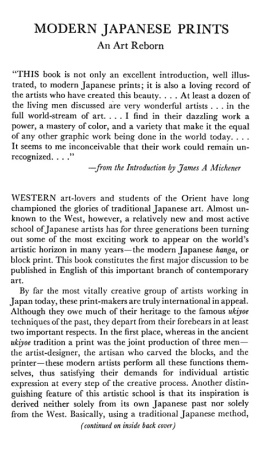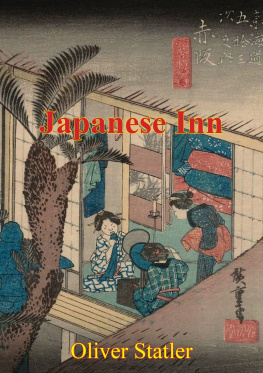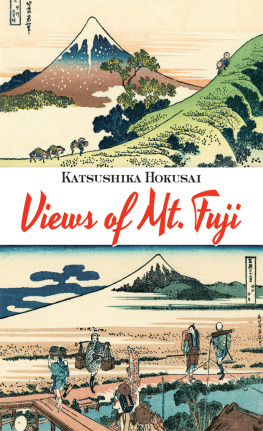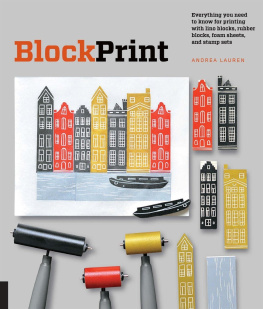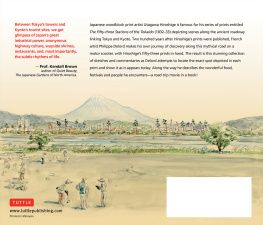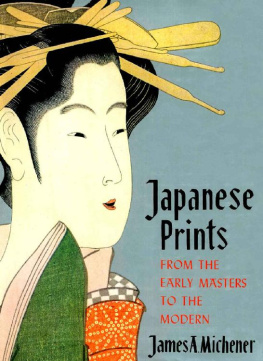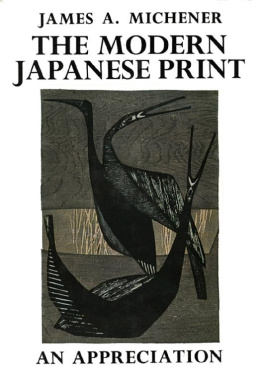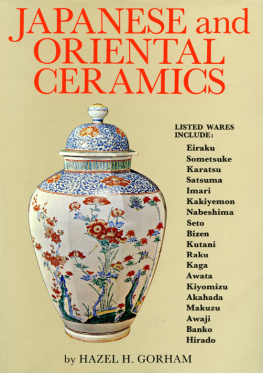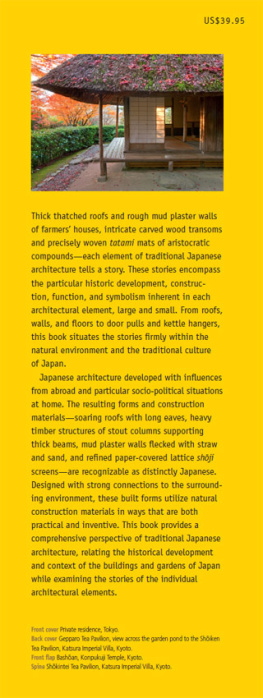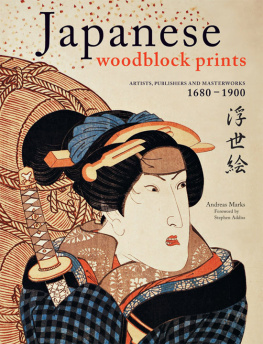The quotation from James A. Michener's The Floating World is used by permission of Random House, New York; the quotation from Langdon Warner's The Enduring Art of Japan, by permission of the Harvard University Press, Cambridge; and the quotation from Elise Grilli's review of the work of Koshiro Onchi, by permission of the writer.
The present work had its genesis in a paper read before the Asiatic Society of Japan on February 14, 1955, a revised version of which was published in Sophia University's quarterly, Monumenta Nipponica, July, 1955. Grateful acknowledgment is made to both the Society and the University for the cooperation which helped to make this publication possible.
APPENDIX 2: THE PRINTS
The following is general and technical information concerning the prints reproduced. In most cases it was obtained from the artist, often with mutual examination of his blocks, his notes, and his working sketches.
Such information about Kanae Yamamoto's prints is limited, because the artist himself is usually the only reliable source. The specific information given for each of his prints was obtained from colleagues and contemporary periodicals and catalogues. In addition, the following is generally true. Date: it is believed that prints signed "Kanae" in roman letters are later prints and were made in Japan. Edition: no accurate information could be obtained; however, before Yamamoto left for Paris a subscription series had been arranged, and several of the smaller prints made in Europe were for this series; the number of subscribers is not known, but the distribution of these prints must have been relatively wide, perhaps 25-50. Blocks: Yamamoto's training as a wood engraver accustomed him to using sakura blocks, and most of his prints were made with sakura; it is believed that he used some ho but no katsura; prints made in Europe were carved on Japanese blocks, which he either took with him or had sent to him. Pigment: usually French water colors, although he took to Europe a supply of the Japanese blue vegetable pigment called at, and in prints made in Japan he is thought to have used sumi for his blacks. Paper: the paper used for each print has been identified, and it may be noted that Yamamoto used Japanese paper for all of his European prints.
The term "printing stages" as used throughout the appendix may require a little explanation. It is used to indicate the number of steps in the printing in which a new element in the design or coloring is introduced; it does not refer to the number of times the artist presses the paper to the block, for he may do this several times in one printing stage in order to obtain depth of color. A single block, however, may incorporate several printing stages: different portions of the block may be used separately, or the same portion more than once, with different colors.
FRONTISPIECE. Koshiro Onchi: Impression of a Violinist. Polychrome impression, 16X12 3/4 in. Published in 1947. Carved, printed, and published by the artist. Edition: 13 (Onchi planned an edition of 20 and numbered his prints accordingly, but never completed the edition); in addition, since Onchi's death, the professional printer Onchi Hirai has been commissioned to print an indefinite number as a memorial edition. Blocks: 2 blocks of solid katsura; 3 printing stages. Pigment: poster colors. Paper: torinoko. Location: Honolulu Academy of Arts and the collection of the author. Notes: Onchi made this print after hearing a concert by Nejiko Suwa, as told in the text. He also wrote a companion poem, dated October 29, 1947, which has been translated as follows (the reader will note the emphasis on yellow; Onchi originally made the violinist's face yellow but quickly eliminated this touch):
Impression of a Violinist
The bow rises strongly into the air.
The artificial lights turned on this violinist's slender body,
How yellow they seem!
On her pale face, on the white silk.
This body passed through a Europe torn with war,
And stands now on the stage of an occupied country.
Ah, the sounds of rubbing strings keep gnawing at one's heart,
How sad a thing art is!
My heart turns yellow, My
tears turn yellow too.
The frontispiece to this book was made available through the kindness of Toyohisa Adachi and the Adachi Institute of Wood-cut Prints. To make this reproduction Hanbei Okura carved 5 blocks of solid katsura; 3 of the blocks were carved from a photograph pasted to the block, and the other 2 blocks were carved by an ukiyoe technique known as mudabori: certain areas already carved on one of the first 3 blocks were recarved on new blocks. For example, the mouth was carved originally on one of the first 3 blocks; an impression was struck off from this block and pasted to a new block as a guide; the mouth was carved on the new block and then cut off the original block (since the mouth is printed with a different color it simplifies printing to have it on a separate block, not too close to other color areas). Four printers (Wasakichi Komatsu, Hatsutaro Kinoshita, Shunosuke Fujii, and Shinzo Toyoda) worked as a team to do the printing in 6 stages, each man working with a different block or blocks. The pigments used were sumi (for the grey and black), beni (for the red of the mouth), and benigara (for the brown of the violin); the beni and benigara are mineral pigments, not the vegetable colors of the same name which were used to make old ukiyoe prints. The paper is white torinoko from Echizen.

